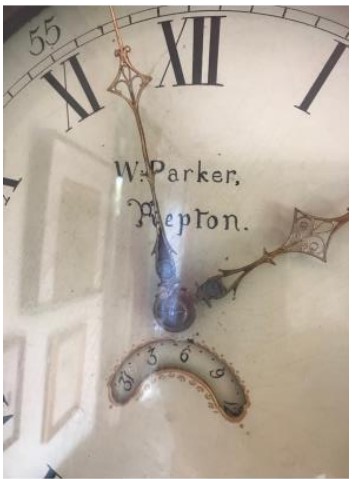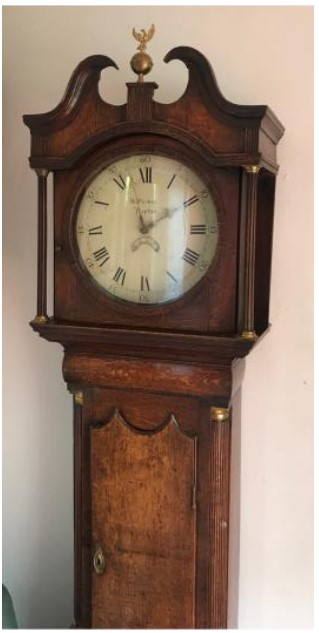Welcome to the Repton Village History Group.
Here you will find a description of the RVHG, including a brief outline of the activities of the group and details of many of the interesting historical facts associated with this ancient community.
Click here for the latest articles and website updates: Latest News
Clockmakers of Repton

When one of our members introduced us to photos of his grandfather clock, we were
surprised to find the dial bore the inscription “William Parker, Repton”. There is no village
memory of clock making here and so we set out to find more about William. The clock had
been bought his father in the 1970s from a cottage behind the NatWest Bank (now 3 The
Cross) and there was an understanding it was made in the 1840s.
Assuming the date was roughly correct and, using the memorials on gravestones in the
churchyard and the early census, we were able to identify the most likely William Parker. His
parents were Hannah and Joseph, a butcher, and he was born in Repton in 1817. He became
a Currier, dressing and finishing leather and was nicknamed Currier Parker. By 1861 he was a
saddler and ironmonger with a shop at the Cross where the school art gallery is now.
According to G A Auden’s notes on Repton in the late 1800s, it had a handsome bow window and his cousin Edward (Tinny) Parker – a tinsmith – also worked out of this shop. It seems a little unlikely that a village leather worker turned ironmonger could design and build clocks but, recently, an internet auction offered yet another one. So it is probable that William bought in mechanisms and made or had the cases made and assembled them for sale.
But he certainly wasn’t the only one. Our researches discovered a number of other clock makers
who put their name and “Repton” on the dial. We found 4 others: Jonathan Jackson (1822),
Herbert Margerison (1908 – 1916), William Newstead (1829), William Porter c 1800 and George
Whitehurst (mid 1700s).

There was an extensive Jackson family with records in Repton from the 1600s right through to
modern times. But no record of a Jonathan or a clockmaker. There were a surprising number of
Herbert Margerisons on the censuses and he should have been here on the 1911 census, but no
documentary record of him in Repton has been found. None of the Margerisons on the 1911
census anywhere, were clockmakers. Neither Jackson or Margerison appear in the Trade
Directories as clockmakers either. We can find no trace of William Porter in Repton. It is possible
that having a clock ascribed to Repton was a good marketing ploy.
William Newstead’s birth was registered in Burton in either 1789 or 1799 and he does appear in
a couple of trade directories as a clockmaker in Repton, but nothing more is known about him.
On the other hand there is quite a story for George Whitehurst. Born in 1721, he was the most illustrious clockmaker associated with Repton. He was brother to the famous John Whitehurst who became a founder member of the Royal and Lunar Societies. Their father was a clockmaker in Cheshire. About 1736 John set up in Derby and designed and made clocks and all sorts of scientific instruments and hydraulic equipment but later moved to London. George ran the Derby Iron Gate works for John but married Ann Trubshaw of Repton in April 1759 in All Saints Derby, and left to set up on his own – presumably in Repton. The Trubshaw name is interesting because about 1715 there had been a famous wrestling match in Repton between Richard Trubshaw and Dick Allin Green of Hucknall. It was also Trubshaws who designed the Willington Bridge. They were a Staffordshire architectural firm.
George and Ann had moved to Repton by 1766 when a settlement certificate was obtained from All Saints and in June 1768 the Constables Accounts records a trip to Eggington (presumably to the Every’s as justices) probably regarding the settlement. The Harpur Crewe rentals records has George taking over the lease on a cottage from Widow Trubshaw (Ann’s mother) and he was still the tenant in 1792 when he died.
So it seems there were clocks made in Repton by William Newstead and George Whitehurst. It is also probable that William Parker made at least two clocks but it might be that, as an ironmonger and the retailer, he had his name put on the face, or he may have bought the movement and assembled the case. Porter, Jackson and Margerison, as fairly peripatetic makers, could have made clocks here, or simply added “Repton” because it was still an important and well known place, but they have left no documentary traces behind them.
